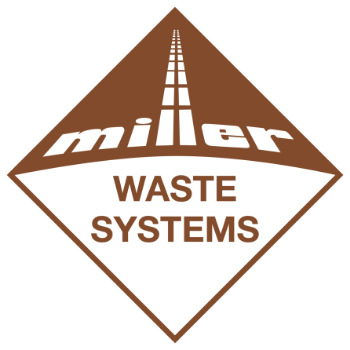Summary
What happens to your recyclables?
Recycling tells a powerful story of transformation and renewal. Not only does it prevent re-usable material from emitting greenhouse gases in a landfill, it creates jobs, sparks ingenuity, and helps natural systems regenerated themselves.
We’re all aware of the benefits of recycling at a high level, but have you ever stopped to wonder about the fate of your recyclables once they’re hauled from your curb? The answers may intrigue (and hopefully inspire) you!
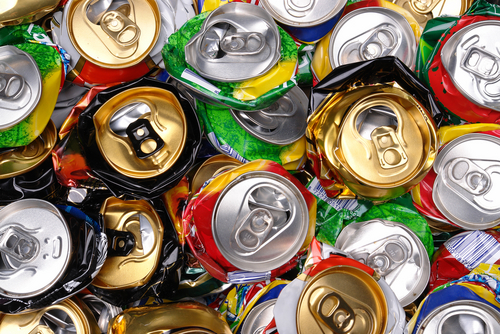
Aluminum Cans
Did you know that aluminum producers in Canada boast a remarkably low carbon footprint compared to their counterparts? This is because aluminum can be recycled indefinitely without any loss in quality. The process of recycling aluminum consumes a staggering 95% less energy than primary production and can be completed in as little as 60 days.
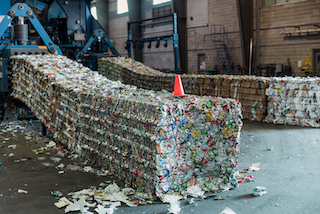
Waste management companies collect aluminum cans from commercial and residential collection programs and transport them to Material Recovery Facilities (MRFs), where they are sorted from other materials with a device called an eddy current. Waste is unloaded onto a conveyor belt and, as it passes under the eddy current, the device emits a brief electric charge to move the cans away from the other, non-magnetic material.
From there, aluminum is compressed into sturdy, compact blocks called bales and shipped to secondary processing facilities, where it is shredded, crushed, loaded into furnaces, and mixed with virgin aluminum.
The molten aluminum is then poured into sheets and fed to rolling mills to reduce the thickness of the metal from roughly 20 inches to 10/1000th of an inch.
Next, the transformed metal is coiled and dispatched to can makers, where it assumes a new identity as new cans, lids, and tabs. Then, the recycled aluminum is ready for its final destination: beverage companies. Remarkably, the average aluminum can in Canada is composed of 70% recycled content, 43% of which is derived from post-consumer scrap metal.
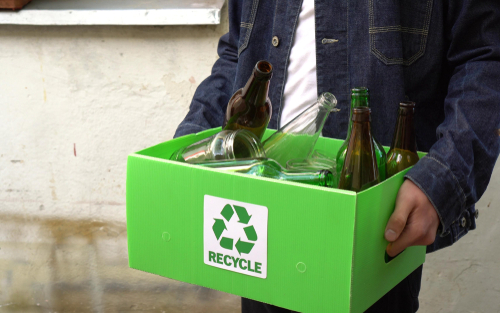
Glass Bottles and Jars
Though infinitely recyclable, glass is tricky to work with due to its propensity to shatter. Many municipalities accept larger glass bottles and jars in curbside collection programs but may advise residents to place smaller items (that are more susceptible to breakage) in the trash. Shards can injure collection staff and damage recycling equipment.
At the MRF, contaminants are removed from glass using a variety of devices: a large, overhead magnet removes metallic components while a trommel removes other pieces of plastic, paper, and organic material from the glass. A trommel is a perforated cylindrical drum – as it rotates, contaminants fall through to a conveyor belt to be processed separately.
The cleaned glass is then crushed into small pieces called cullets and sold to secondary processors who further treat the glass depending on the intended application.
About 20% of glass collected with other materials is marketed as fine glass and used in road aggregates or as a sandblasting base. Another 40-60% are used in the manufacture of fiberglass, new bottles and jars, high traction road surfaces, and construction aggregate.

Plastic
Not all plastic is created equal – and not every type of plastic is accepted at the curb. Please consult your municipality’s recycling guidelines to determine which kind of plastic you can toss into your bin.
Here’s how the most commonly accepted plastic is recycled:
#1 Plastic – PET (Polyethylene terephthalate)

Common Uses: Water and soda bottles, containers for fruit, baked goods, and cooking oil.
PET (Polyethylene terephthalate) bottles are the second most common type of non-refillable beverage containers in Canada (the most common being glass).
When PET containers enter the MRF, some are manually removed from the waste stream by MRF employees; the rest are separated by an optical sorter. A beam of infrared light is emitted from the sorter and reflects differently off different polymer types. Once identified by the beam, polymer types are directed into the appropriate bin by a short blast of air.
PET material is then baled in preparation for shipment to secondary processors, where the bales are shredded into delicate flakes that manufacturers use to produce fleece clothing and apparel, carpet underlays, and new bottles.
Most post-consumer PET bottles are reclaimed in North America, with a negligible amount exported overseas.
#2 Plastic HDPE (High Density Polyethylene)
HDPE has many uses; its high melting point means it can be sterilized to meet the standards of the food industry – as such, it’s often used to create milk jugs and cutting boards. Its resistance to oil and corrosion makes it suitable for bleach, antifreeze, and motor oil, too.
HDPE’ is also easier to recycle than other plastics – secondary processors can easily mold melted HDPE into new shapes without any loss to the material’s structural integrity. Some studies even suggest that virgin HDPE can be recycled up to 10 times!
At the MRF, HDPE is manually and optically separated from other materials, packaged into bales, and shipped to secondary processors who chip, wash, and melt the plastic into small pellets. The pellets are used to manufacture new containers, lumber and decking, pipe, automotive components, lawn and garden products, furniture, and toys.
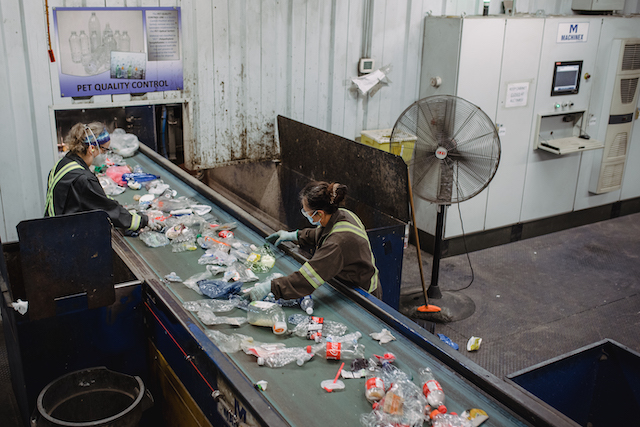
Paper
At the MRF, large fans blow flat and wide items like old corrugated containers (OCC), magazines, newspapers, and food packaging, off the conveyor belt and away from other items like bottles, cans, and jars. The paper items ride across large disk screens onto another conveyor belt where staff remove contaminants in the form of plastic, metal, and glass.
The paper is then sorted based on grade, which is determined by the length of the fibers. Paper and cardboard fibers become shorter and weaker with each round of recycling until they become too short to make into new paper. At this is point, they are mixed with virgin fibers to produce new material.
The sorted paper is compacted into bales and shipped to paper and pulping mills where they undergo a series of chemical and mechanical processes to become new paper, egg cartons, pencil barrels, and paper grocery bags.

No act of recycling is too small to make an impact. When done continuously and at scale, recycling benefits everyone by improving the health of people and the planet and helps us combat the global challenges of pollution, climate change, and the loss of biodiversity.
Click here to find a recycling depot near you.
